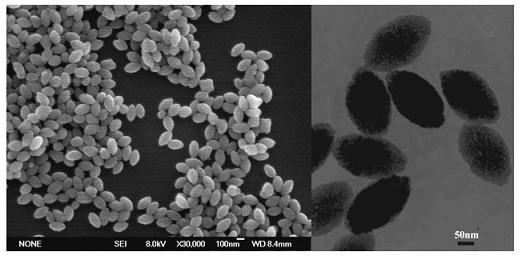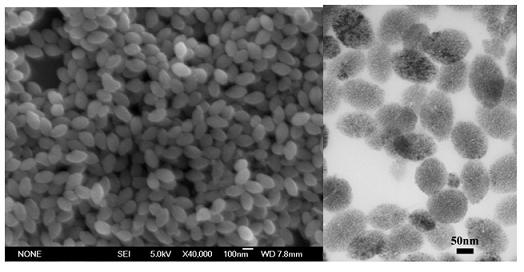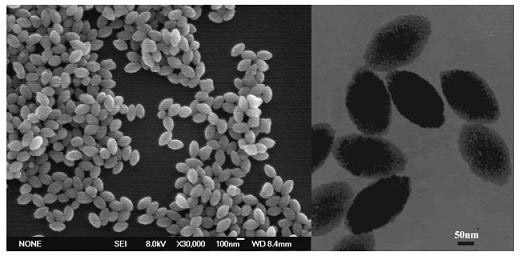Preparation method of monodisperse granular amorphous nanometer TiO2
An amorphous, monodisperse technology, applied in the preparation of amorphous nano-TiO2, the preparation of monodisperse rice-like amorphous nano-TiO2, can solve the problems of difficult to control size, structure and morphology, harsh reaction conditions, etc., to achieve shape Uniformity, low preparation cost, good monodispersity effect
- Summary
- Abstract
- Description
- Claims
- Application Information
AI Technical Summary
Problems solved by technology
Method used
Image
Examples
Embodiment 1
[0018] (1) Add 0.05 mol·L -1 Ti(SO 4 ) 2 and 10 g L -1 Dissolve polyvinylpyrrolidone in water, add 3.5% (volume ratio) H 2 o 2 as a complexing agent;
[0019] (2) Transfer the above mixed solution to a tetrafluoroethylene-lined autoclave, heat at a constant temperature of 100 °C for 1 h, then raise the temperature to 200 °C for 1 h, and finally adjust to 80 °C for 20 h to obtain a TiO-containing 2 the mixture;
[0020] (3) The above-mentioned containing TiO 2 After the mixture was cooled, it was centrifuged at 10,000 r / min for 10 min, the upper layer was discarded, and washed three times with water and ethanol to obtain white TiO 2 Precipitate;
[0021] (4) Put the precipitate obtained in step (3) into a drying oven at 80 °C for 24 h to obtain monodisperse amorphous nano-TiO 2 .
Embodiment 2
[0023] (1) Dilute 1.0 mol·L -1 Ti(SO 4 ) 2 and 10 g L -1 Dissolve polyvinylpyrrolidone in water, add 7% (volume ratio) of H 2 o 2 as a complexing agent;
[0024] (2) Transfer the above mixed solution to a high-pressure reactor lined with tetrafluoroethylene, heat at 100 °C for 1 h, then raise the temperature to 200 °C for 1 h, and finally adjust to 80 °C for 20 h to obtain TiO-containing 2 the mixture;
[0025] (3) The above-mentioned containing TiO 2 After the mixture was cooled, it was centrifuged at 10,000 r / min for 10 min, the upper layer was discarded, and washed three times with water and ethanol to obtain white TiO 2 Precipitate;
[0026] (4) Put the precipitate obtained in step (3) into a drying oven at 80 °C for 24 h to obtain monodisperse amorphous nano-TiO 2 .
[0027]
Embodiment 3
[0029] (1) Add 0.05 mol·L -1 Ti(SO 4 ) 2 and 10 g L -1 Dissolve polyvinylpyrrolidone in water, add 3.5% (volume ratio) H 2 o 2 ;
[0030] (2) Transfer the above mixed solution to a high-pressure reactor lined with tetrafluoroethylene, heat at a constant temperature of 100 °C for 1 h, then raise the temperature to 240 °C for 30 min, and finally adjust to 60 °C for 24 h to obtain a TiO-containing 2 the mixture;
[0031] (3) The above-mentioned containing TiO 2 After the mixture was cooled, it was centrifuged at 10,000 r / min for 10 min, the upper layer was discarded, and washed three times with water and ethanol to obtain white TiO 2 Precipitate;
[0032] (4) Put the precipitate obtained in step (3) into a drying oven at 80 °C for 24 h to obtain monodisperse amorphous nano-TiO 2 .
[0033] The powder X-ray diffraction pattern of sample does not appear obvious diffraction peak, shows that the TiO prepared by the method of the present invention 2 The product is amorphou...
PUM
 Login to View More
Login to View More Abstract
Description
Claims
Application Information
 Login to View More
Login to View More - R&D
- Intellectual Property
- Life Sciences
- Materials
- Tech Scout
- Unparalleled Data Quality
- Higher Quality Content
- 60% Fewer Hallucinations
Browse by: Latest US Patents, China's latest patents, Technical Efficacy Thesaurus, Application Domain, Technology Topic, Popular Technical Reports.
© 2025 PatSnap. All rights reserved.Legal|Privacy policy|Modern Slavery Act Transparency Statement|Sitemap|About US| Contact US: help@patsnap.com



